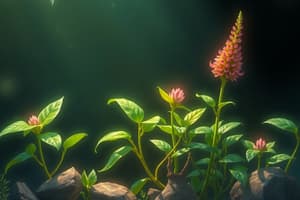Podcast
Questions and Answers
Plant growth and development involves the processes of growth and ______
Plant growth and development involves the processes of growth and ______
differentiation
The structure of a cell, a tissue, an organ, and the function they perform are all ______
The structure of a cell, a tissue, an organ, and the function they perform are all ______
related
Why does the vegetative phase precede flowering in a plant? Because of the action of ______
Why does the vegetative phase precede flowering in a plant? Because of the action of ______
regulators
All cells of a plant are descendants of the ______
All cells of a plant are descendants of the ______
Why and how do plant cells have different structural and functional attributes? Because of the processes of growth and ______
Why and how do plant cells have different structural and functional attributes? Because of the processes of growth and ______
What are the two processes that make up development? Growth and ______
What are the two processes that make up development? Growth and ______
During ______ development, a complex body organization is formed that produces roots, leaves, branches, flowers, fruits, and seeds, and eventually they die (Figure 15.1). In this chapter, you shall also study some of the factors which govern and control these developmental processes. These factors are both intrinsic (internal) and extrinsic (external) to the ______.
During ______ development, a complex body organization is formed that produces roots, leaves, branches, flowers, fruits, and seeds, and eventually they die (Figure 15.1). In this chapter, you shall also study some of the factors which govern and control these developmental processes. These factors are both intrinsic (internal) and extrinsic (external) to the ______.
Growth is regarded as one of the most fundamental and conspicuous characteristics of a living being. What is growth. Growth can be defined as an irreversible permanent increase in size of an organ or its parts or even of an individual cell. Generally, growth is accompanied by metabolic processes (both anabolic and catabolic), that occur at the expense of energy. Therefore, for example, expansion of a leaf is growth. How would you describe the ______ of piece of wood when placed in water.
Growth is regarded as one of the most fundamental and conspicuous characteristics of a living being. What is growth. Growth can be defined as an irreversible permanent increase in size of an organ or its parts or even of an individual cell. Generally, growth is accompanied by metabolic processes (both anabolic and catabolic), that occur at the expense of energy. Therefore, for example, expansion of a leaf is growth. How would you describe the ______ of piece of wood when placed in water.
Plant growth is unique because plants retain the capacity for unlimited growth throughout their life. This ability of the plants is due to the presence of ______s at certain locations in their body. The cells of such ______s have the capacity to divide and self-perpetuate. The product, however, soon loses the capacity to divide and such cells make up the plant body. This form of growth wherein new cells are always being added to the plant body by the activity of the ______ is called the open form of growth. What would happen if the ______ ceases to divide. Does this ever happen.
Plant growth is unique because plants retain the capacity for unlimited growth throughout their life. This ability of the plants is due to the presence of ______s at certain locations in their body. The cells of such ______s have the capacity to divide and self-perpetuate. The product, however, soon loses the capacity to divide and such cells make up the plant body. This form of growth wherein new cells are always being added to the plant body by the activity of the ______ is called the open form of growth. What would happen if the ______ ceases to divide. Does this ever happen.
You know that they are responsible for the 2015-16(19/01/2015) PLANT GROWTH AND DEVELOPMENT primary growth of the plants and principally contribute to the elongation of the plants along their axis. You also know that in dicotyledonous plants and gymnosperms, the ______ meristems, vascular cambium and cork-cambium appear later in life. These are the meristems that cause the increase in the girth of the organs in which they are active. This is known as secondary growth of the plant (see Figure 15.2).
You know that they are responsible for the 2015-16(19/01/2015) PLANT GROWTH AND DEVELOPMENT primary growth of the plants and principally contribute to the elongation of the plants along their axis. You also know that in dicotyledonous plants and gymnosperms, the ______ meristems, vascular cambium and cork-cambium appear later in life. These are the meristems that cause the increase in the girth of the organs in which they are active. This is known as secondary growth of the plant (see Figure 15.2).
Growth, at a cellular level, is principally a Vascular ______ of increase in the amount of cambium Root protoplasm. Since increase in protoplasm is difficult to measure directly,.
Growth, at a cellular level, is principally a Vascular ______ of increase in the amount of cambium Root protoplasm. Since increase in protoplasm is difficult to measure directly,.
Flashcards are hidden until you start studying




